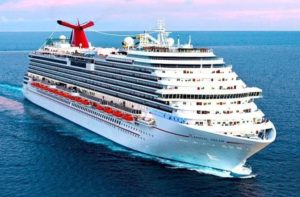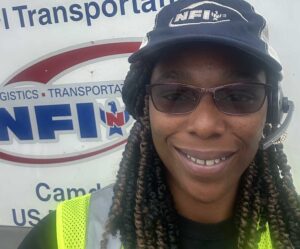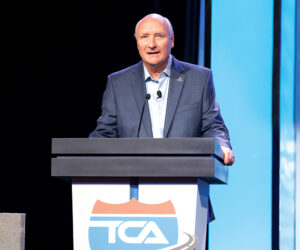Cleaning out the notebook while wondering when it’s going to stop raining every week …
* * *
A couple of weeks ago, my wife and I had the privilege of taking a week-long cruise on the Carnival Dream out of New Orleans.
The ship docked at 7 a.m. May 5.
It was scheduled to leave for its final voyage out of New Orleans at 4 p.m. that afternoon (the Dream is being relocated to a new home port in Galveston, Texas, and will make shorter trips in the Caribbean.

You only have to be around a ship of that magnitude to appreciate the role trucking plays in that transition from inbound to outbound.
At 15 decks high and one thousand feet long, the Dream would be the largest building in most American cities and towns.
On a cruise, its population is larger than most of those cities and towns.
It has a capacity of 3,646 guests and operates with a crew of 1,367, all of whom have to eat at least three meals a day.
The ship serves over 14,000 meals a day.
Imagine the tons of meat, fruit and veggies and paper goods that have to be loaded at the home port, because we didn’t see any tractor-trailers on the docks at ports in Jamaica, the Cayman Islands and Cozumel.
How does all that food get to the home dock?
Mostly in big rigs, which are at the pier when the ship docks and continue to unload their cargo into the ship well up into the day.
In fact, as we drove away from the pier, there were several tractor-trailers queued up on a road leading to the port area.
I’m sure most of those 3.600 guests on our ship took for granted how those goods and supplies got to the ship.
We didn’t.
* * *
From time to time, you see articles in our paper and on our website about Highway Angels (Truckload Carriers Association) and Highway Heroes (Goodyear Tire and Rubber Co.).
Once in a while, we get a nomination from a reader, in this case of former professional truck driver Veronica Fiorina, who writes:
“On March 11, trucker Johnnie Gillins, Jr., an owner-operator contracted to CFI, was driving his truck on Interstate 4 heading east from Tampa, Florida, on the way home to Lakeland, Florida. He observed the driving of a day cab swerving over the white lines into other traffic, then returning to his lane.
“This was happening continually. He did manage to write down the transport’s name and truck number as well as the truck license.
“As the driver neared Exit 33, he negotiated the off ramp at an extremely high rate of speed and swerved to the left and drove off the road. The day cab rolled over with trailer still connected and the driver was wedged between the steering wheel and floor.
“Johnnie stopped immediately, but was unable to open either door. The driver of the day cab seemed to be unconscious and was not replying to shouts. Johnnie called 911 and waited for professional people to arrive to assess the driver’s injuries, secure the area against possible fires and to give a report to the police.
“Johnnie showed concern for a fellow driver and took the initiative to stop. More people should set an example and show that kind of empathy. His company has a good driver.”
We are told the driver of the day cab was not seriously injured and is now OK.
Way to go, Johnnie. And thanks, Veronica.
Lyndon Finney’s publishing career spans over 55 years beginning with a reporter position with the Southwest Times Record in Fort Smith, Arkansas, in 1965. Since then he’s been a newspaper editor at the Southwest Times Record, served five years as assistant managing editor of the Arkansas Democrat-Gazette in Little Rock and from November 2004 through December 2019 served as editor of The Trucker. Between newspaper jobs he spent 14 years as director of communications at Baptist Health, Arkansas’ largest healthcare system. In addition to his publishing career he served for 46 years as organist at Little Rock’s largest Baptist church.








